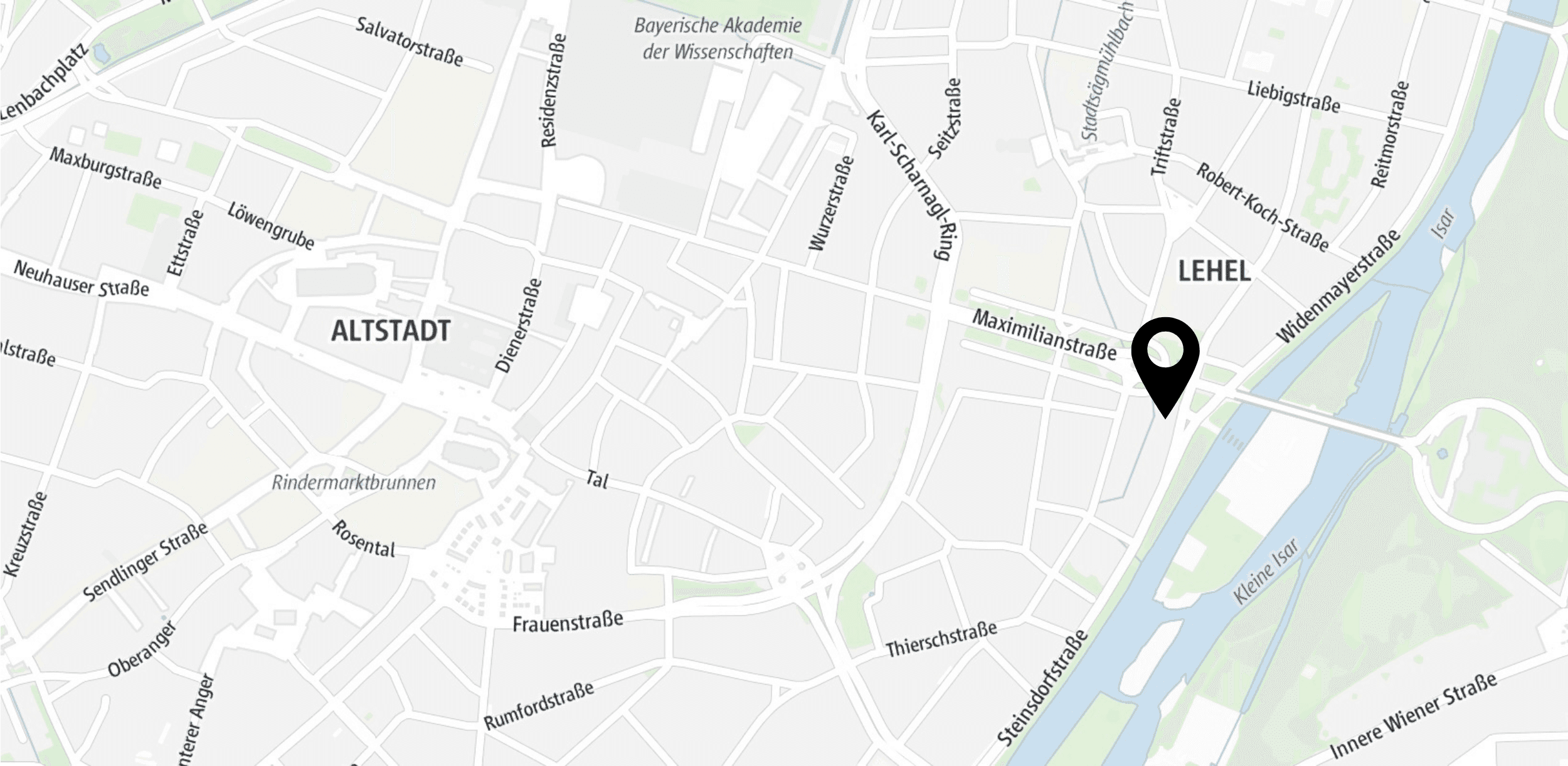The rise of AI has sparked a lot of debate: Is AI replacing marketers? Are SEOs going to be made redundant as AI takes over? Let’s clear up some misconceptions right from the start.
SEO is a dynamic field, constantly evolving with shifts in search engine algorithms, user behavior, and technological advancements. Among the most transformative changes is the rise of AI, which is reshaping the SEO landscape, especially in the e-commerce sector. As AI continues to make waves, it’s natural for questions to arise: Will AI replace human expertise in SEO? Could AI eventually render SEOs obsolete? Let’s explore these questions and see where AI truly fits into the future of SEO, including in e-commerce.
1. The Rise of AI in SEO
Here is the grain of truth: SEO has always been a dynamic field, adapting to the evolving search ecosystem. However, it’s also important to understand the dimension of how SEO practices have to constantly adapt exactly to this said ecosystem: From changes in SERP features to algorithm updates, SEO practitioners have continuously evolved their strategies to stay ahead. However, this also means that SEO has its own fragility since it is dependent on said changes. Now AI entered the field as a player in the ecosystem, still evolving, and has yet to decide what kind of role it will play in the chart. For sure, it is an additional factor that influences the SEO field. At least for now, it means AI could be a powerful force augmenting the role of tools and techniques that SEOs rely on.
Far from making SEO professionals obsolete, AI is redefining its role by enabling more measurable, impactful, and efficient practices. For e-commerce businesses, AI-driven tools are unlocking new ways to optimize websites and product pages, create engaging content, and deliver personalized customer experiences. Rather than focusing on cutting workloads, the real promise of AI lies in its ability to make SEO efforts more strategic and result-oriented.
In this article, we will explore the transformative impact of AI on SEO, diving into the tools and techniques that are reshaping the field. From streamlining workflows to improving the alignment of content strategies with audience personas, AI is helping SEOs not only meet but exceed their goals in an increasingly competitive landscape.
2. E-Commerce SEO and its Role in Branding
2.1 What is E-Commerce SEO?
E-commerce SEO is the process of improving an online store’s organic rankings in search engines such as Google and Bing. It helps drive more shoppers to your website by improving your online visibility. Without using paid ads. (SEMrush)
E-commerce SEO focuses on unique aspects of e-commerce websites, such as optimizing product and category pages, improving site architecture, resolving technical issues like duplicate content, and enhancing user experience. This includes keyword research for purchase-intent terms, image and video optimization, and creating supportive content like buying guides and FAQs. The ultimate goal of e-commerce SEO is to ensure customers can easily find products and complete their purchases, making it a conversion-driven approach, overall creating a great user experience.
Before we dive into the changes that AI brings to the table, let’s have a look at the traditional process in e-commerce SEO. For that, we could take a further look at how product pages are built and how SEO helps assist the brand’s online influence.
What role does SEO exactly play in E-Commerce?
SEO plays a vital role in e-commerce by helping brands become more discoverable and attracting potential customers. By optimizing the website’s SEO elements, businesses improve their business potential. This is because optimizing SEO also improves their relevance to potential customers, making their website more likely to rank better and be found in search results.
Below are the advantages of optimizing SEO for your brand (e-commerce SEO):
- Increased Visibility: Higher search engine rankings make the e-commerce site more visible to potential customers searching for relevant products or services.
- Organic Traffic: SEO is a primary driver of organic traffic, bringing in potential customers who are actively seeking solutions and are more likely to convert.
- Brand Awareness: Consistent SEO efforts establish the brand as an authority in the industry, building trust and credibility with potential customers.
- Improved User Experience: SEO often involves optimizing website structure and content for better user experience, which can lead to higher engagement and conversion rates.
- Competitive Advantage: By outperforming competitors in search results, businesses gain a significant competitive advantage in the online marketplace.
So now we are starting to see how AI can power these different elements of your brand and elevate it. By seamlessly integrating advanced technologies, AI has the capability to enhance pretty much everything about your brand. Remember that SEO is not just about making your website perform better; it’s about making the search engine understand its relevance so potential customers can reach it better. But this horizon is actually wider than it looks.
Because when you are talking about the website, it also means you are talking about the branding, the product pages, and other category pages such as blogs or service pages that are supposed to play their own role - all while maintaining a good site structure and performance as your brand (and your website) grows. So the next question is, where does AI come into play? Obviously, I wouldn’t be writing this if I was only talking about writing assistants. I am talking about the elements of e-commerce itself, where some processes in the traditional sense were all manual and very time-consuming.
But AI is more than capable of cutting down redundancy in those processes. It can analyze data, predict trends, and generate creative solutions, ultimately helping your brand stand out in a crowded market. With AI, you’re not just optimizing individual components—you’re elevating your brand as a whole, fostering deeper connections with your audience, and creating a more dynamic, innovative presence in the industry.
3. AI-Powered E-Commerce SEO Tools
Now the awaited time has come to explore the full spectrum of brand building. We'll begin by establishing a solid foundation, guiding you through a sequential process rather than a mere list of tools. This journey encompasses everything from developing a comprehensive brand manual to conducting detailed competitor research. And you're absolutely right, the first step is creating a strong, unified brand manual.
3.1. Creating a Brand Manual with Gingersauce
What is a brand manual?
A brand manual, also known as a brand style guide, defines the core elements that shape a brand’s identity, including its visual design, such as logo, tone of voice, messaging, and guidelines for consistent communication across all channels. Its role is to ensure brand consistency, which fosters recognition, trust, and credibility among target audiences. This consistency is essential not only for customer perception but also for SEO, as it helps maintain uniformity in on-page elements like meta descriptions, headings, and content structure. A strong, cohesive brand presence enhances user experience and reinforces E-E-A-T (Experience, Expertise, Authoritativeness, Trustworthiness) signals, which are key factors for improving search engine rankings.
When building a brand, a brand manual is essential for defining how you want to communicate your identity to the world. However, hiring a professional designer can be costly, and not everyone has the budget for it. While some people turn to tools like Canva to create their brand manuals, they often face limitations since Canva’s features aren’t specifically designed for developing comprehensive brand books.
For a more tailored solution, Gingersauce offers an excellent alternative, providing specialized tools that make it easy to create professional, cohesive brand manuals without the need for a large budget or design expertise. Here is my experience using it:
I created a fake tech company called bluewave to have a full-throttle experience of using AI-generated tools, to help me build a company from zero. This is the first look of Gingersauce, which is pretty user-friendly. Signing up is quick and easy, without requiring payment information submission for a trial. Every user gets one free brandbook, and this is exactly what I use.
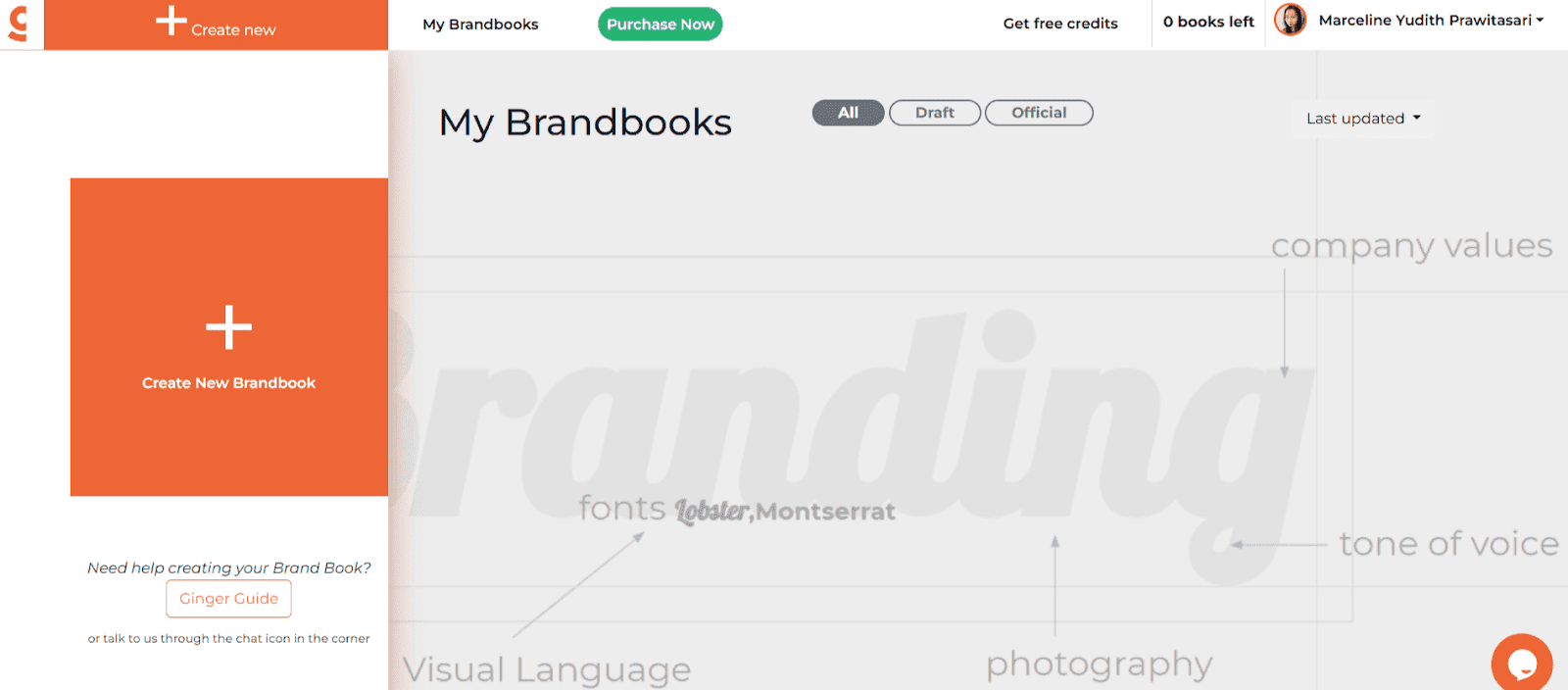
Illustration: Screenshot of Gingersauce
The only thing you need to know is that logo creation is not included in their service, you already need a logo ready as SVG file. So I quickly created one using Canva, which is also free. The only catch is that the export from Canva is in PNG format, so you will need to convert it to SVG, but there are free tools online you can utilize. Anyway, let’s get back to the fake company I am building; bluewave:
Bluewave is a tech-driven platform designed to help companies build from the ground up. We empower entrepreneurs and startups with a comprehensive, one-stop suite of tools for market research, vision and mission development, and strategic launch planning. Whether you're refining your business idea, identifying target audiences, or mapping out go-to-market strategies, Bluewave streamlines the process to help you launch with confidence and clarity.
Our mission is to help people start and grow their online businesses—not just through creativity, but by leveraging data to craft strategies that drive sustainable growth and revenue.
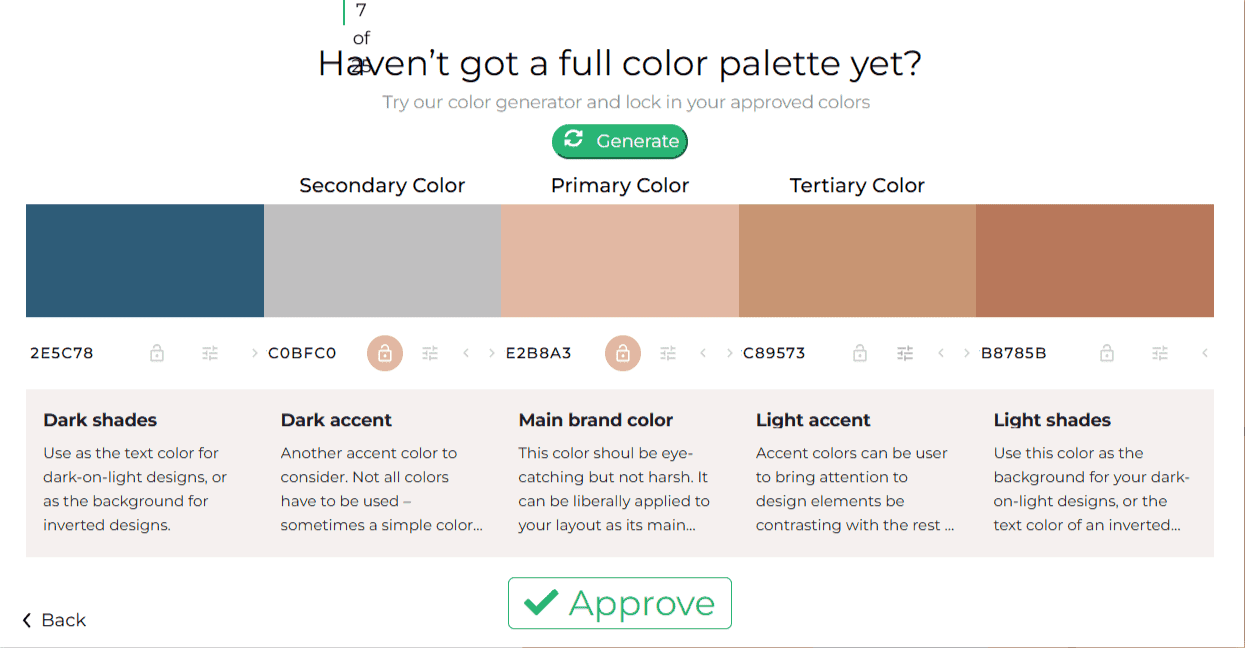
Illustration: Color palette suggested by Gingersauce
In hindsight, I have created a (fake) company with a mission and branding strategy as clear as I could without needing to fill all the fields required, but I did fill in the ones I think are important such as: logo, fonts (I used ChatGPT to suggest me fonts for the brand), mission statement, adjectives you will use for your brand, and the archetype you envision. It even provided you with details as to choosing the proportion you would like for your logo. Of course, I chose Fibonacci.
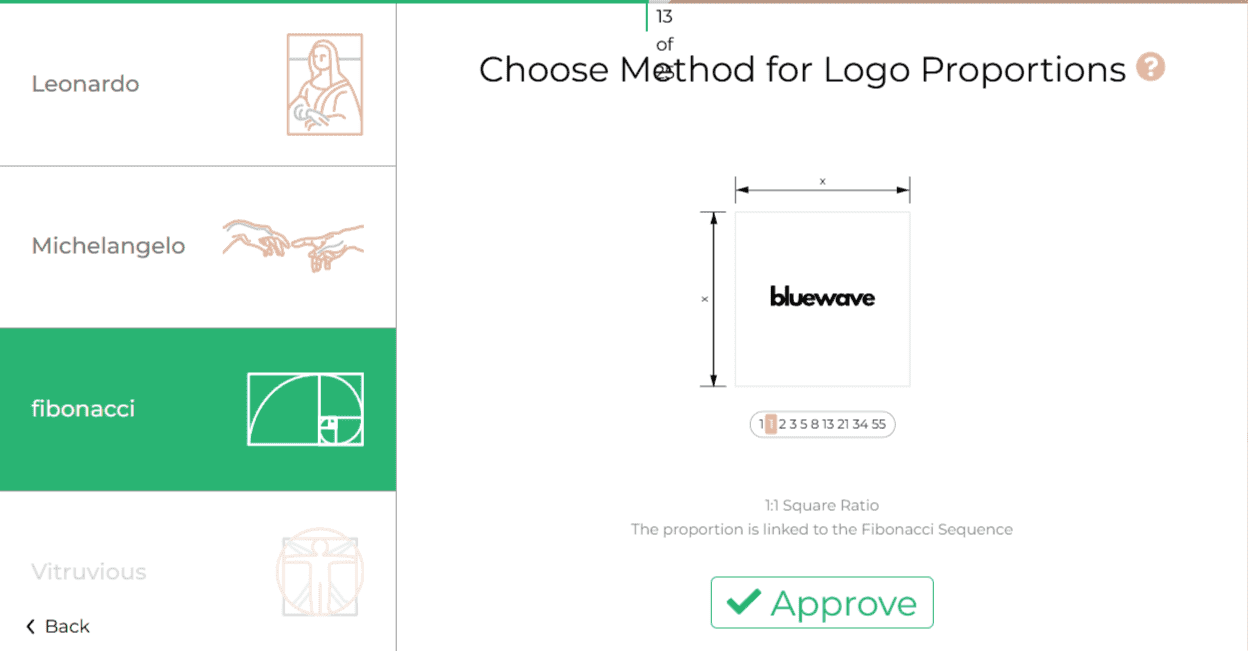
Long story short, after having the brand guide for bluewave generated, here’s my take after testing Gingersauce:
Pros:
- Easy to use and no payment info required (only email login)
- Friendly UI even for beginners
- Color palette is automatically generated and several options are provided.
Cons:
- The generated brand manual is only available online, and is not downloadable
- Logo is required in order to generate the brand manual
- Fonts need to be chosen manually. They are not automatically generated, nor is any recommendations provided.
Just a quick disclaimer: having a professional create a brand manual typically costs at least €1,000, with the average price often falling closer to €2,500. Since a brand manual requires attention to detail that only an experienced designer can provide—given its highly specialized nature—using Gingersauce offers a viable alternative, particularly for smaller companies with limited budgets.
3.2. Building a Product Page that Converts: Sitecore Stream
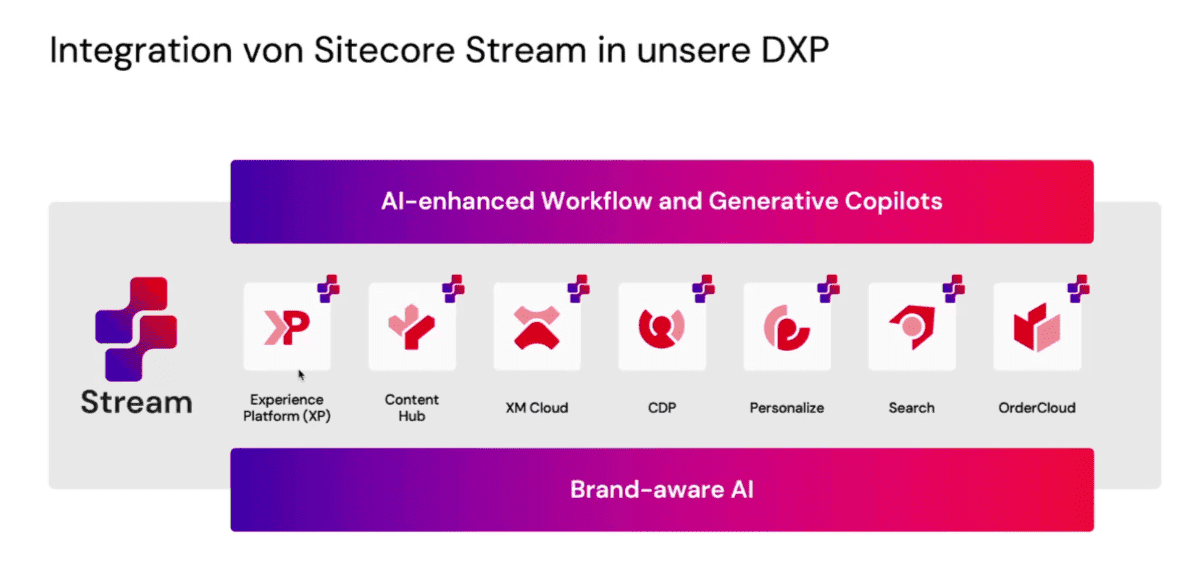
Illustration: Screenshot of Sitecore Stream
Once you have the brand manual, especially if you are in the e-commerce business, then the next step is to create a product page. I stumbled upon Sitecore Stream while attending a panel in an AI conference. The speaker was practically doing a live demo of the DXP tool, which was quite fascinating.
As a person who has built many product pages across various business niches, I can tell you that when done manually, this is quite a redundant process. The reason is that when you do it manually, you have to look back to the brand manual for every single item you are checking. There is no benchmark 100% reliable since it’s frankly impossible to measure, how much your product description matches your tone of voice. Every professional might have a slightly different opinion. On top of that, there is an additional layer to consider, such as regulations for certain products, such as edibles, that come into play.
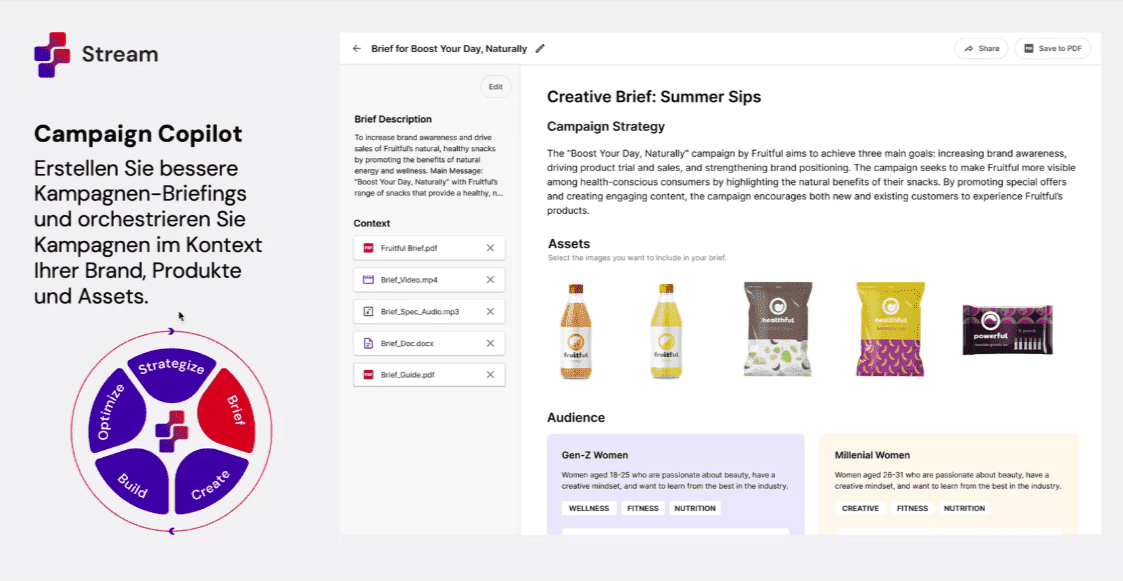
Illustration: Campaign Copilot of Sitecore Stream
What Sitecore Stream does is to cut those redundancies and automate the process, while you, as a human, just need to undertake Quality Assurance and orchestrate the whole process. However, similar to any AI tool - it is still important to add a human factor as a QA layer to the process.
Pros:
- Automates product page creation, saving time and ensuring brand consistency.
- Reduces manual labor and redundancy.
- Helps with regulatory compliance.
Cons:
- Still requires human QA, for instance because TOV can be a subjective matter
- Demo booking process is redundant
3.3. Create Product Campaigns with CapCut Commerce
Every influencer knows CapCut because, well, they are probably using it. CapCut is a great video editing tool, that also has AI-powered features such as AI effects and automatic subtitle generation. But what about marketers? Is CapCut Commerce as reliable as the OG CapCut? I am also a CapCut user and understand how powerful it is, so I was quite excited with this one.
However, the CapCut commerce is a different feature altogether. First of all, it is a much simpler tool than the OG CapCut. While the OG CapCut is a complex elaborated tool that is able to equip your basic shots so you can turn them into amazing videos. Meanwhile, CapCut commerce is a simpler, more straightforward tool, that simply scrapes information from a product page and AI-generates content. Let’s try first with a product that I like. I took this blue dress from Sister Jane - a small indie fashion brand from the UK - and see what happens.
As you can see, it’s not all that great. The flow is a little awkward, the use of images is a little clunky, and it definitely needs more fine-tuning. Let’s try with another product that everyone is more familiar with, and is easier to incorporate into a video format. Everyone has at least seen Graza’s social media campaign at least once, and they are pretty darn good. Let’s see how CapCut Commerce handles this one. So here is what it looks like, for the sake of a more objective review, I will leave the automated version as it is, without any fine-tuning - although there are options for it, as you see below:
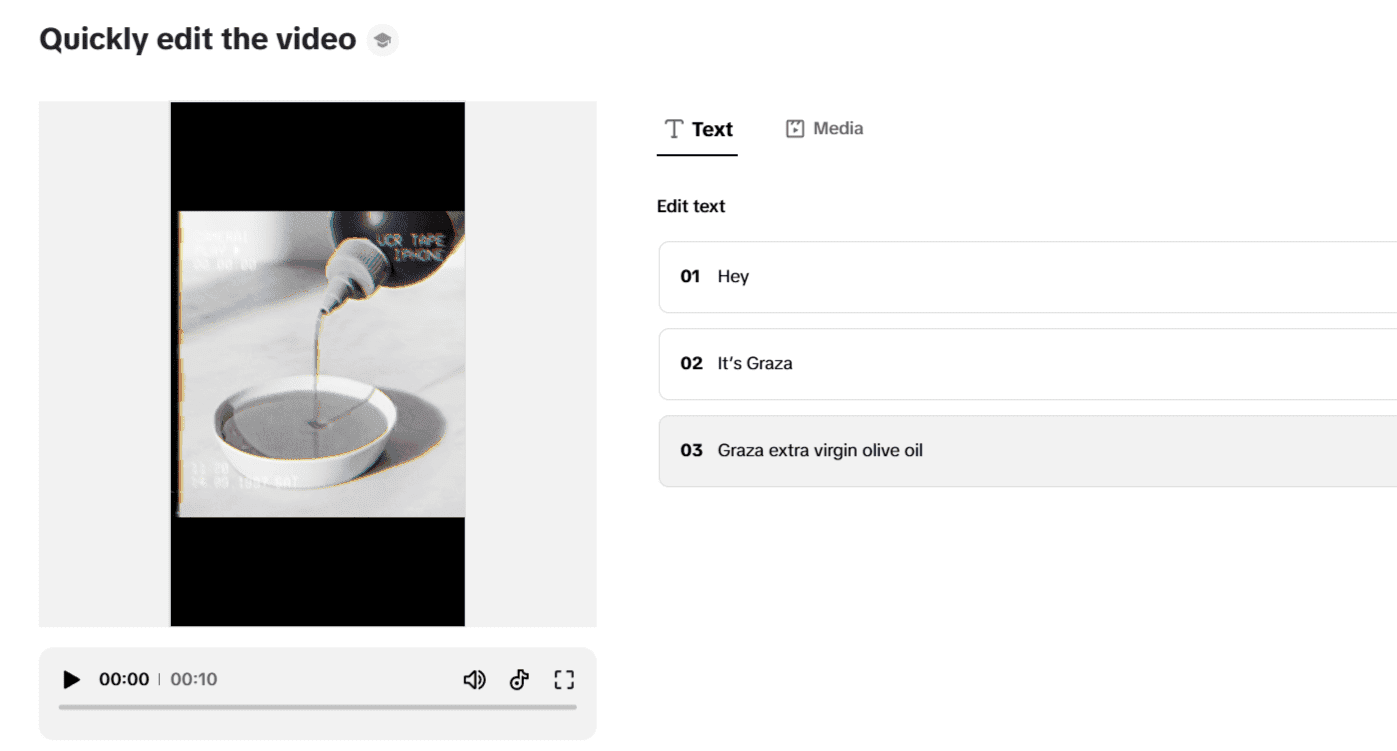
Illustration: Screenshot Result from CapCut
So for Graza, it is looking a little better - but in the end, you will also still notice the cropped text and the image usage. I have to admit, the quality is better than the asset generated for Sister Jane. However, it still requires a lot of manual fine-tuning, and it still makes mistakes - which I think still needs to be improved before brand owners can freehandedly use it.
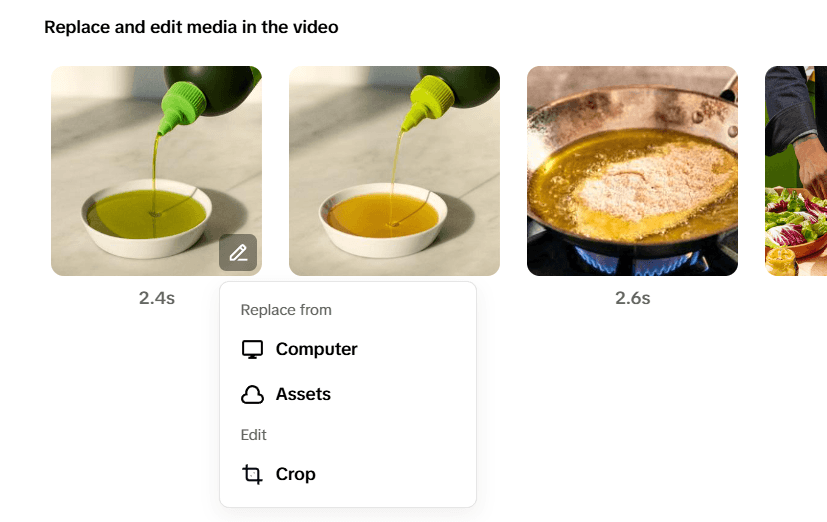
Illustration: Screenshot of CapCut’s fine-tuning possibilities
Pros:
- Practical to use since it rapidly generates product videos and images using AI
- Seamless integration with platforms like Shopify and TikTok Shop.
- Vast variety of premade templates.
Cons:
- Often pulls the wrong product name. It could for instance pull the collection name or tagline instead.
- The AI-generated avatar could still look unnatural, despite lipsync being accurate to the words spoken.
3.4. Leveraging Data for Competitor Research with Particl
While having your product page, social media posts, and campaigns ready is a good start, launching without prior competitor research can be a costly mistake. Analyzing competitors before launch allows you to identify market gaps, adjust your strategy, and avoid potential pitfalls.
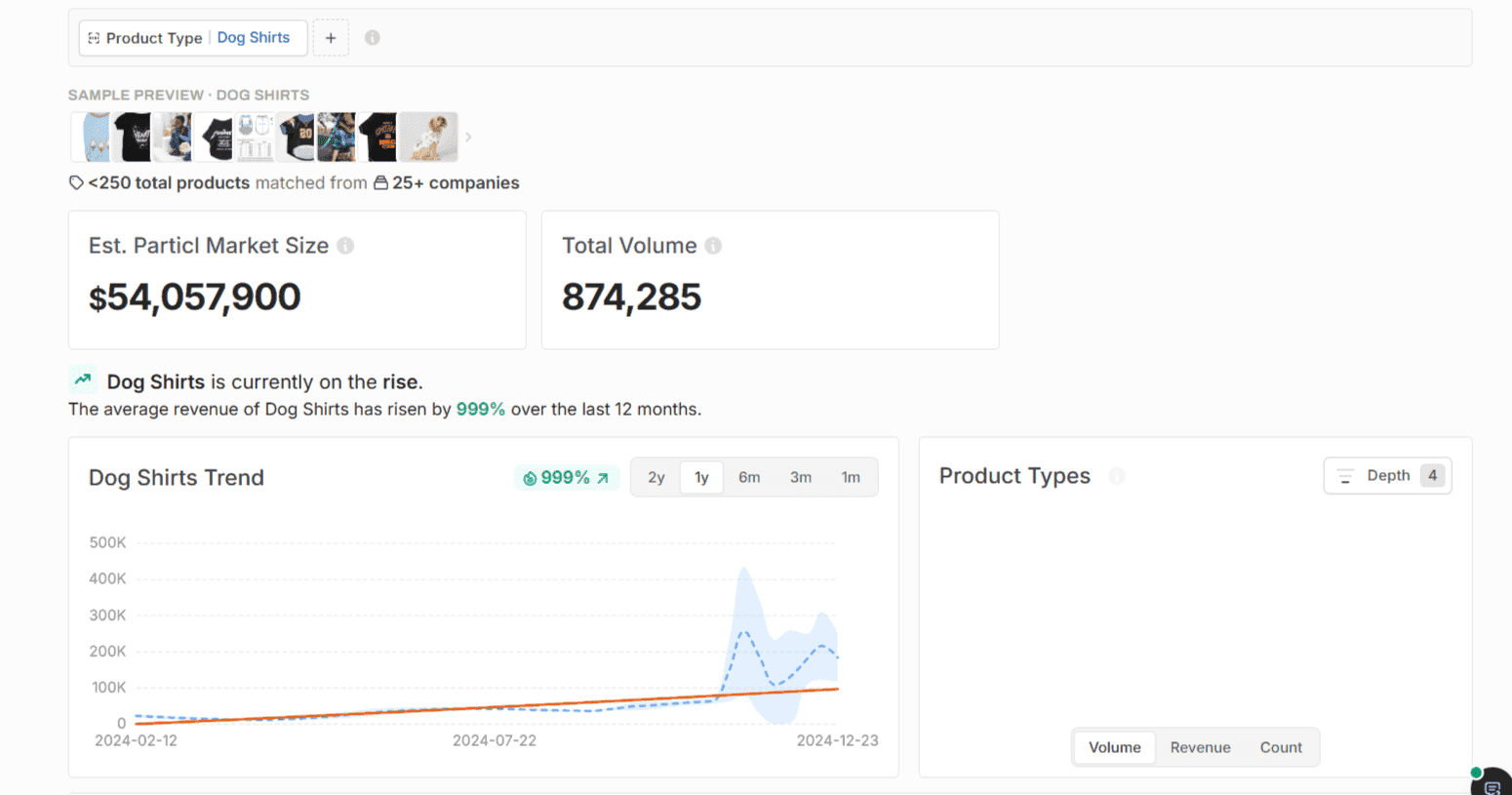
Illustration: Screenshot Particl
At a glance, the tool gives a familiar feeling since the interface is pretty similar to the classical SEO tools like Ahrefs and SEMrush - even though it’s a completely different tool altogether. To start with, getting access to the tool is hassle-free, and the interface is pretty straightforward even for beginners. As seen above, checking trends has never been made so easy. You can easily search the performance of specific products - in this example we are seeing how the trend of dog shirts has significantly increased by the end of 2024; which shows this might be influenced by the seasonal holidays.
So bear in mind that this is just the starting point, because we are using the limited features of the free package - the paid option has a wider range of functions such as benchmarking. This function leverages AI to compare products against competitors and identify the "white space" opportunities; which are areas where there's unmet market demand. This feature helps businesses discover the most profitable product variations and categories. I mean, even the free functionality allows you to check the best-selling products of other brands:
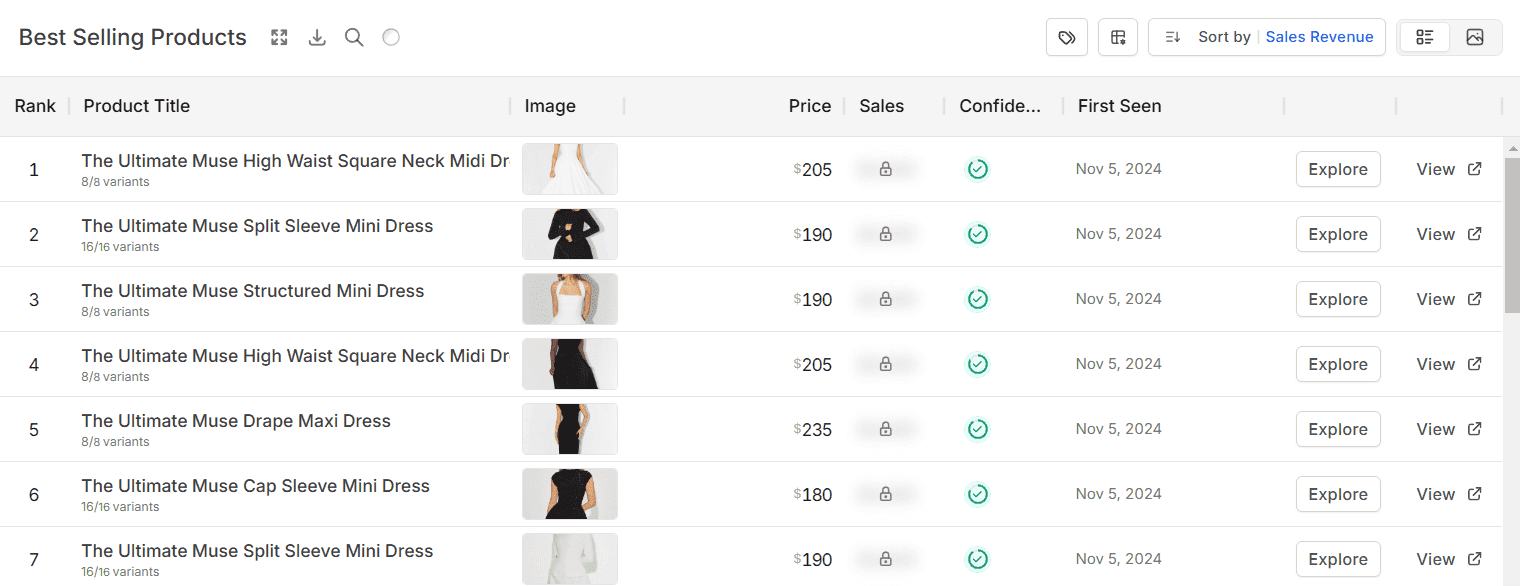
Illustration: Screenshot of competitor analysis
Using another trending name, this time from the fashion industry (which fashionista doesn’t know Odd Muse?), we can easily use the search function to check any brands available and see their top selling products. Overall, Particl is an amazing tool, though there are things that I would still like to note. That said, here are the pro and cons:
Pros:
- Free plan for those who just want to try out the tool
- Centralizes data, freeing up business resources for analysis.
- Thorough competitor analysis through trend, top sellers, pricing strategies, and inventory. Is also able to spot white space potential
Cons:
- May not track every company.
- May not capture every single e-commerce company or product, some niches are more covered than others.
- Particl openly admits that their estimates are not perfect and that a degree of uncertainty is inherent in their data, meaning it may not be able to be used as the only source of truth.
Key Takeaway: The Future of AI in SEO
The rise of AI in SEO is not about replacing human expertise, but rather about augmenting it. It is essential to underline, that we need to shift our focus from merely cutting workloads to leveraging AI for more measurable and impactful SEO practices. AI-powered tools provide unprecedented opportunities to demonstrate the value of SEO through concrete results, enabling us to move beyond subjective assessments. However, as AI evolves, ethical considerations regarding data privacy, bias, and transparency become paramount. This will require SEOs to adopt a responsible and mindful approach.
The future SEO professional will be a blend of technical expert, business strategist, and researcher. They should use AI to enhance their work and drive strategic decision-making. SEO workflows will inevitably adapt, with AI automating routine tasks and freeing up human resources for higher-level strategic and creative endeavors. In the realm of e-commerce, this translates to SEO professionals leveraging AI to optimize product visibility, enhance customer journeys, and drive conversions through data-driven strategies. That said, human-level QA is still important - even with a majority of the workflow being automated. Ultimately, AI enables a holistic approach to SEO, optimizing various aspects of a brand's online presence to create a cohesive and impactful brand experience. By embracing AI and prioritizing measurable impact, SEOs can solidify their role as essential contributors in the ever-evolving digital landscape.









